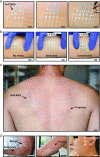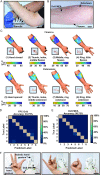Customizable, reconfigurable, and anatomically coordinated large-area, high-density electromyography from drawn-on-skin electrode arrays
- PMID: 36712933
- PMCID: PMC9837666
- DOI: 10.1093/pnasnexus/pgac291
Customizable, reconfigurable, and anatomically coordinated large-area, high-density electromyography from drawn-on-skin electrode arrays
Erratum in
-
Correction to: Volume 2 Issue 1 of PNAS Nexus.PNAS Nexus. 2023 Jan 27;2(1):pgad016. doi: 10.1093/pnasnexus/pgad016. eCollection 2023 Jan. PNAS Nexus. 2023. PMID: 36744020 Free PMC article.
Abstract
Accurate anatomical matching for patient-specific electromyographic (EMG) mapping is crucial yet technically challenging in various medical disciplines. The fixed electrode construction of multielectrode arrays (MEAs) makes it nearly impossible to match an individual's unique muscle anatomy. This mismatch between the MEAs and target muscles leads to missing relevant muscle activity, highly redundant data, complicated electrode placement optimization, and inaccuracies in classification algorithms. Here, we present customizable and reconfigurable drawn-on-skin (DoS) MEAs as the first demonstration of high-density EMG mapping from in situ-fabricated electrodes with tunable configurations adapted to subject-specific muscle anatomy. The DoS MEAs show uniform electrical properties and can map EMG activity with high fidelity under skin deformation-induced motion, which stems from the unique and robust skin-electrode interface. They can be used to localize innervation zones (IZs), detect motor unit propagation, and capture EMG signals with consistent quality during large muscle movements. Reconfiguring the electrode arrangement of DoS MEAs to match and extend the coverage of the forearm flexors enables localization of the muscle activity and prevents missed information such as IZs. In addition, DoS MEAs customized to the specific anatomy of subjects produce highly informative data, leading to accurate finger gesture detection and prosthetic control compared with conventional technology.
© The Author(s) 2022. Published by Oxford University Press on behalf of National Academy of Sciences.
Figures





Similar articles
-
Flexible Multielectrode Arrays With 2-D and 3-D Contacts for In Vivo Electromyography Recording.IEEE Trans Compon Packaging Manuf Technol. 2020 Feb;10(2):197-202. doi: 10.1109/tcpmt.2019.2963556. Epub 2020 Jan 1. IEEE Trans Compon Packaging Manuf Technol. 2020. PMID: 32280561 Free PMC article.
-
Muscle-Specific High-Density Electromyography Arrays for Hand Gesture Classification.IEEE Trans Biomed Eng. 2022 May;69(5):1758-1766. doi: 10.1109/TBME.2021.3131297. Epub 2022 Apr 21. IEEE Trans Biomed Eng. 2022. PMID: 34847014
-
Stable, three degree-of-freedom myoelectric prosthetic control via chronic bipolar intramuscular electrodes: a case study.J Neuroeng Rehabil. 2019 Nov 21;16(1):147. doi: 10.1186/s12984-019-0607-8. J Neuroeng Rehabil. 2019. PMID: 31752886 Free PMC article.
-
Interpretation of EMG changes with fatigue: facts, pitfalls, and fallacies.J Electromyogr Kinesiol. 2003 Feb;13(1):13-36. doi: 10.1016/s1050-6411(02)00083-4. J Electromyogr Kinesiol. 2003. PMID: 12488084 Review.
-
The linear electrode array: a useful tool with many applications.J Electromyogr Kinesiol. 2003 Feb;13(1):37-47. doi: 10.1016/s1050-6411(02)00082-2. J Electromyogr Kinesiol. 2003. PMID: 12488085 Review.
Cited by
-
Self-powered electrotactile textile haptic glove for enhanced human-machine interface.Sci Adv. 2025 Mar 21;11(12):eadt0318. doi: 10.1126/sciadv.adt0318. Epub 2025 Mar 21. Sci Adv. 2025. PMID: 40117358 Free PMC article.
-
Wearable bioelectronics fabricated in situ on skins.Npj Flex Electron. 2023;7(1):32. doi: 10.1038/s41528-023-00265-0. Epub 2023 Jul 17. Npj Flex Electron. 2023. PMID: 38665149 Free PMC article. Review.
-
Recent Progress in Biosensors for Depression Monitoring-Advancing Personalized Treatment.Biosensors (Basel). 2024 Aug 30;14(9):422. doi: 10.3390/bios14090422. Biosensors (Basel). 2024. PMID: 39329797 Free PMC article. Review.
References
-
- Milosevic B, Benatti S, Farella E. 2017. Design challenges for wearable EMG applications. Des Aut Test Europe. 2017:1432–1437.
-
- Drost G, Stegeman DF, van Engelen BG, Zwarts MJ. 2006. Clinical applications of high-density surface EMG: a systematic review. J Electromyogr Kines. 16:586–602. - PubMed
-
- Afsharipour B, Soedirdjo S, Merletti R. 2019. Two-dimensional surface EMG: the effects of electrode size, interelectrode distance and image truncation. Biomed Signal Proces. 49:298–307.
LinkOut - more resources
Full Text Sources

